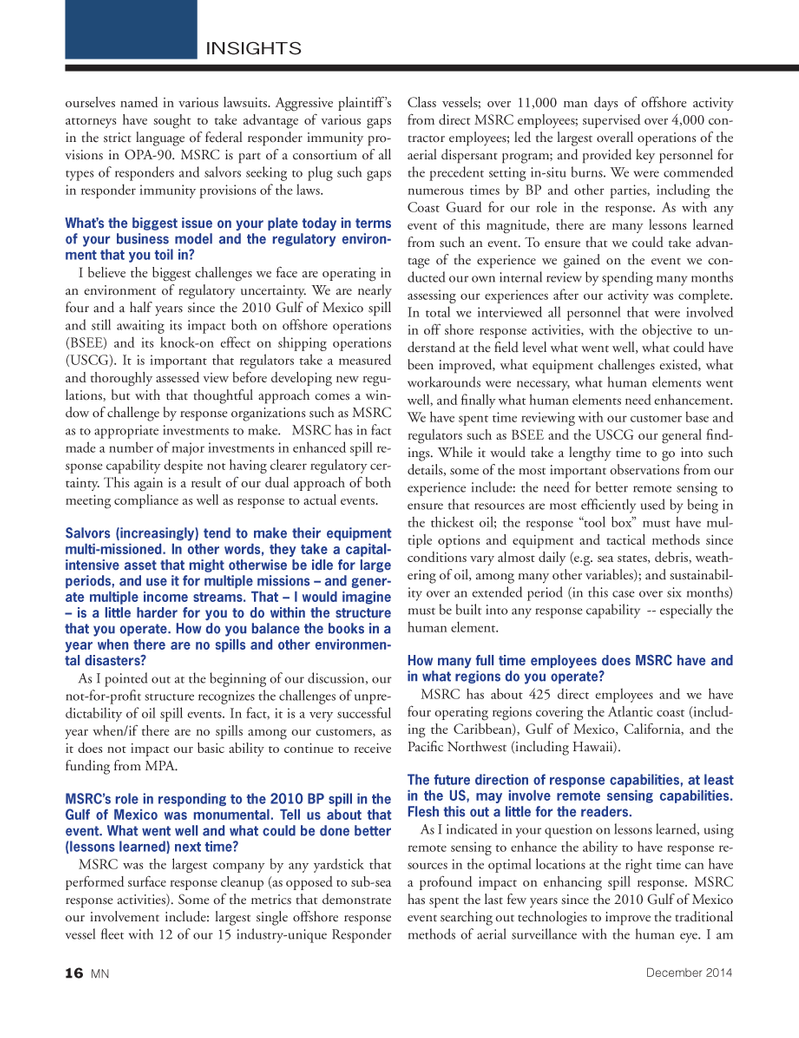
Page 16: of Marine News Magazine (December 2014)
Salvage & Spill Response
Read this page in Pdf, Flash or Html5 edition of December 2014 Marine News Magazine
ourselves named in various lawsuits. Aggressive plaintiff?s attorneys have sought to take advantage of various gaps in the strict language of federal responder immunity pro- visions in OPA-90. MSRC is part of a consortium of all types of responders and salvors seeking to plug such gaps in responder immunity provisions of the laws. What?s the biggest issue on your plate today in terms of your business model and the regulatory environ- ment that you toil in?I believe the biggest challenges we face are operating in an environment of regulatory uncertainty. We are nearly four and a half years since the 2010 Gulf of Mexico spill and still awaiting its impact both on offshore operations (BSEE) and its knock-on effect on shipping operations (USCG). It is important that regulators take a measured and thoroughly assessed view before developing new regu- lations, but with that thoughtful approach comes a win- dow of challenge by response organizations such as MSRC as to appropriate investments to make. MSRC has in fact made a number of major investments in enhanced spill re- sponse capability despite not having clearer regulatory cer- tainty. This again is a result of our dual approach of both meeting compliance as well as response to actual events. Salvors (increasingly) tend to make their equipment multi-missioned. In other words, they take a capital- intensive asset that might otherwise be idle for large periods, and use it for multiple missions ? and gener- ate multiple income streams. That ? I would imagine ? is a little harder for you to do within the structure that you operate. How do you balance the books in a year when there are no spills and other environmen- tal disasters?As I pointed out at the beginning of our discussion, our not-for-pro t structure recognizes the challenges of unpre- dictability of oil spill events. In fact, it is a very successful year when/if there are no spills among our customers, as it does not impact our basic ability to continue to receive funding from MPA. MSRC?s role in responding to the 2010 BP spill in the Gulf of Mexico was monumental. Tell us about that event. What went well and what could be done better (lessons learned) next time?MSRC was the largest company by any yardstick that performed surface response cleanup (as opposed to sub-sea response activities). Some of the metrics that demonstrate our involvement include: largest single offshore response vessel eet with 12 of our 15 industry-unique Responder Class vessels; over 11,000 man days of offshore activity from direct MSRC employees; supervised over 4,000 con- tractor employees; led the largest overall operations of the aerial dispersant program; and provided key personnel for the precedent setting in-situ burns. We were commended numerous times by BP and other parties, including the Coast Guard for our role in the response. As with any event of this magnitude, there are many lessons learned from such an event. To ensure that we could take advan- tage of the experience we gained on the event we con- ducted our own internal review by spending many months assessing our experiences after our activity was complete. In total we interviewed all personnel that were involved in off shore response activities, with the objective to un- derstand at the eld level what went well, what could have been improved, what equipment challenges existed, what workarounds were necessary, what human elements went well, and nally what human elements need enhancement. We have spent time reviewing with our customer base and regulators such as BSEE and the USCG our general nd-ings. While it would take a lengthy time to go into such details, some of the most important observations from our experience include: the need for better remote sensing to ensure that resources are most ef ciently used by being in the thickest oil; the response ?tool box? must have mul- tiple options and equipment and tactical methods since conditions vary almost daily (e.g. sea states, debris, weath- ering of oil, among many other variables); and sustainabil- ity over an extended period (in this case over six months) must be built into any response capability -- especially the human element.How many full time employees does MSRC have and in what regions do you operate? MSRC has about 425 direct employees and we have four operating regions covering the Atlantic coast (includ- ing the Caribbean), Gulf of Mexico, California, and the Paci c Northwest (including Hawaii). The future direction of response capabilities, at least in the US, may involve remote sensing capabilities. Flesh this out a little for the readers. As I indicated in your question on lessons learned, using remote sensing to enhance the ability to have response re- sources in the optimal locations at the right time can have a profound impact on enhancing spill response. MSRC has spent the last few years since the 2010 Gulf of Mexico event searching out technologies to improve the traditional methods of aerial surveillance with the human eye. I am INSIGHTSDecember 201416 MNMN Dec14 Layout 1-17.indd 16MN Dec14 Layout 1-17.indd 1611/24/2014 3:52:58 PM11/24/2014 3:52:58 PM

 15
15

 17
17
